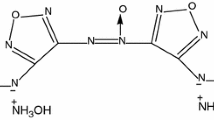Abstract
Compatibility is the ability of materials to resist chemical changes when they interact with other materials. Both the compatibility and interaction between energetic materials or between energetic and non-energetic materials are of great importance. Differential scanning calorimetry was performed to investigate the compatibility and the interaction between the energetic materials. The thermal characterization of energetic materials is important to indicate their stability as propellants, revealing necessary information regarding their thermal decomposition mechanisms during combustion and storage. The energetic materials include guanidinium azo-tetrazolate (GAT), aminoguanidinium azo-tetrazolate (AGAT), aminoguanidinium azo-tetrazolate monohydrate (AGATH), diaminoguanidinium azo-tetrazolate (DAGAT), triaminoguanidinium azo-tetrazolate (TAGAT), and ammonium azo-tetrazolate (AZT). Azo-tetrazolate salts and their derivatives were synthesized and fully characterized by multinuclear spectroscopy and Fourier transform infrared spectroscopy. The results present good compatibility between GAT–AGATH, GAT–DAGAT, GAT–TAGAT, GAT–AZT, AGAT–DAGAT, and DAGAT–TAGAT. The decomposition of AGATH and DAGAT was increased by adding GAT and TAGAT, respectively. There were poor compatibility between GAT and AGAT and fair compatibility between AGAT and TAGAT, and the mixtures of AGAT–AZT, DAGAT–AZT, and TAGAT–AZT might be hazardous. Adding any other energetic material to GAT accelerates the decomposition temperature of GAT, which may be useful in some applications.











Similar content being viewed by others
References
Huang H, Shi Y, Yang J, Li B. Compatibility study of dihydroxylammonium 5,5′-bistetrazole-1,1′-diolate (TKX-50) with some energetic materials and inert materials. J Energ Mater. 2015;33:66–72.
Jizhen L, Xuezhong F, Xiping F, Fengqi Z, Rongzu H. Compatibility study of 1,3,3-trinitroazetidinewith some energetic components and inert materials. J Therm Anal Calorim. 2006;85:779–84.
Li J, Wang B, Fan X, Wei H, Fu X, Zhou C, Huo H. Interaction and compatibility between DAAzF and some energetic materials. Def Technol. 2013;9:153–6.
Li X, Lin Q, Peng J, Wang B. Compatibility study between 2,6-diamino-3,5-dinitropyrazine-1-oxide and some high explosives by thermal and nonthermal techniques. J Therm Anal Calorim. 2017;127:2225–31.
Liao L, Wei H, Li J, Fan X, Zheng Y, Ji Y, Fu X, Zhang Y, Liu F. Compatibility of PNIMMO with some energetic materials. J Therm Anal Calorim. 2012;109:1571–6.
Mazzeu MAC, Mattos EdC, Iha K. Studies on compatibility of energetic materials by thermal methods. J Aerosp Technol Manag. 2010;2:53–8.
Myburgh A. Standardization on STANAG test methods for ease of compatibility and thermal studies. J Therm Anal Calorim. 2006;85:135–9.
Pang W, Fan X, Xue Y, Xu H, Zhang W, Zhang X, Li Y, Li Y, Shi X. Study on the compatibility of tetraethylammonium decahydrodecaborate (BHN) with some energetic components and inert materials. Propellants Explos Pyrotech. 2013;38:278–85.
Pei J, Zhao F, Lu H, Song X, Zhou R, Yuan Z, Zhang J, Chen J. Compatibility study of BAMOGAP copolymer with some energetic materials. J Therm Anal Calorim. 2016;124:1301–7.
Yan Q, Li X, Liao L, Zhang X, Liu Z. Compatibility of trans-1, 4, 5, 8-tetranitro-1, 4, 5, 8-tetraazadacalin (TNAD) with some propellant components evaluated by DSC method. Chin J Energ Mater. 2008;16:309–14.
Bellamy AJ, Dearing SL. The incompatibility of RDX and lead. Propellants Explos Pyrotech. 2002;27:352–60.
Golofit T, Zysk K. Thermal decomposition properties and compatibility of CL-20 with binders HTPB, PBAN, GAP and polyNIMMO. J Therm Anal Calorim. 2015;119:1931–9.
Warner KF, Granholm RH. Synthesis of insensitive 5,5′-azotetrazolate salts. J Energ Mater. 2011;29:1–6.
Hammerl A, Hiskey MA, Holl G, Klapoetke TM, Polborn K, Stierstorfer J, Weigand JJ. Azidoformamidinium and guanidinium 5,5′-azotetrazolate salts. Chem Mater. 2005;17:3784–93.
Hiskey MA, Goldman N, Stine JR. High-nitrogen energetic materials derived from azotetrazolate. J Energ Mater. 1998;16:119–27.
Hudson MK, Wright AM, Luchini C, Wynne PC, Rooke S. Guanidinium azo-tetrazolate (GAT) as a high performance hybrid rocket fuel additive. J Pyrotech. 2004;19:37–42.
Lai W, Ge Z, Lian P, Yu T, Chen X, Qiu S, Wang B. Density functional theoretical study of 5, 5′-azotetrazolate nonmetallic salts. Def Technol. 2013;9:133–8.
Laus G, Kahlenberg V, Wurst K, Schottenberger H, Fischer N, Stierstorfer J, Klapoetke TM. Synthesis and crystal structures of new 5,5′-azotetrazolates. Crystals. 2012;2:127–36.
de Klerk W, van der Meer N, Eerligh R. Microcalorimetric study applied to the comparison of compatibility tests (VST and IST) of polymers and propellants. Thermochimica acta. 1995;269:231–43.
NATO Standardisation Agreement (STANAG) 4147, Chemical compatibility of ammunition components with explosives (nonnuclear applications); AC/310 (SG1) D/15 (Draft edition 2) I-96 NAVY/ARMY/AIR.
Acknowledgements
Support from the Arkansas Space Grant Consortium (ASGC) NNX15AR71H in the form of a Research Infrastructure Award for this work plus multiple-year STEM awards for Ms. Yousef is gratefully acknowledged. Also, the use of the UA Little Rock Nanotech Center Thermal Lab is gratefully acknowledged. The generous assistance of Dr. Fumiya Watanabe, Dr. Omar Abdulrazzaq, Dr. Shawn Bourdo, and Dr. Viney Saini is appreciated. Ms. Missy Hill and Ms. Laura Holland were very helpful to Ms. Yousef during her studies. This work was partially presented at the 2016 ACS National Meeting (Philadelphia), 2016 UA Little Rock Research EXPO, and the Arkansas Space Grant Consortium 2016 Annual Symposium (Hot Springs).
Author information
Authors and Affiliations
Corresponding author
Electronic supplementary material
Below is the link to the electronic supplementary material.
Rights and permissions
About this article
Cite this article
Yousef, M.A., Hudson, M.K. & Berry, B.C. Study on the compatibility of azo-tetrazolate high-energy materials using DSC. J Therm Anal Calorim 133, 1481–1490 (2018). https://doi.org/10.1007/s10973-018-7221-z
Received:
Accepted:
Published:
Issue Date:
DOI: https://doi.org/10.1007/s10973-018-7221-z



